This guide will walk you through everything you need to know about exterior cladding for your garden room. From understanding the materials available to step-by-step instructions for installation and long-term maintenance, this post is your ultimate resource.
Cladding can take any garden room from basic to iconic, combining both style and durability to create a long-lasting, aesthetically pleasing outdoor space. But how do you choose the right cladding material, and more importantly, how do you install it properly?
What Is Garden Room Cladding and Why Does It Matter?
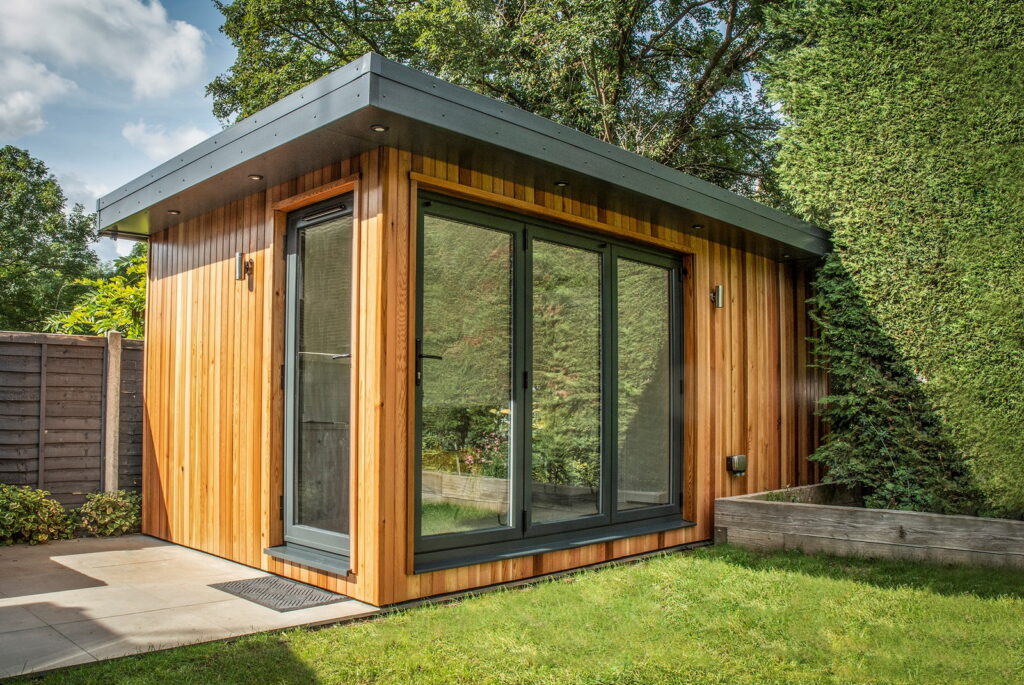
Cladding refers to the external layer or covering of a structure, designed to provide protection and enhance its appearance. For garden rooms, cladding serves a dual purpose—it protects the building from the elements while also acting as a design feature that elevates the space.
Choosing the right cladding material isn’t just about aesthetics; it’s about ensuring your garden room can withstand weather conditions, maintain energy efficiency, and stand the test of time.
Want to create a garden room that’s both functional and beautiful? Cladding is where it all begins.
Types of Garden Room Cladding Materials
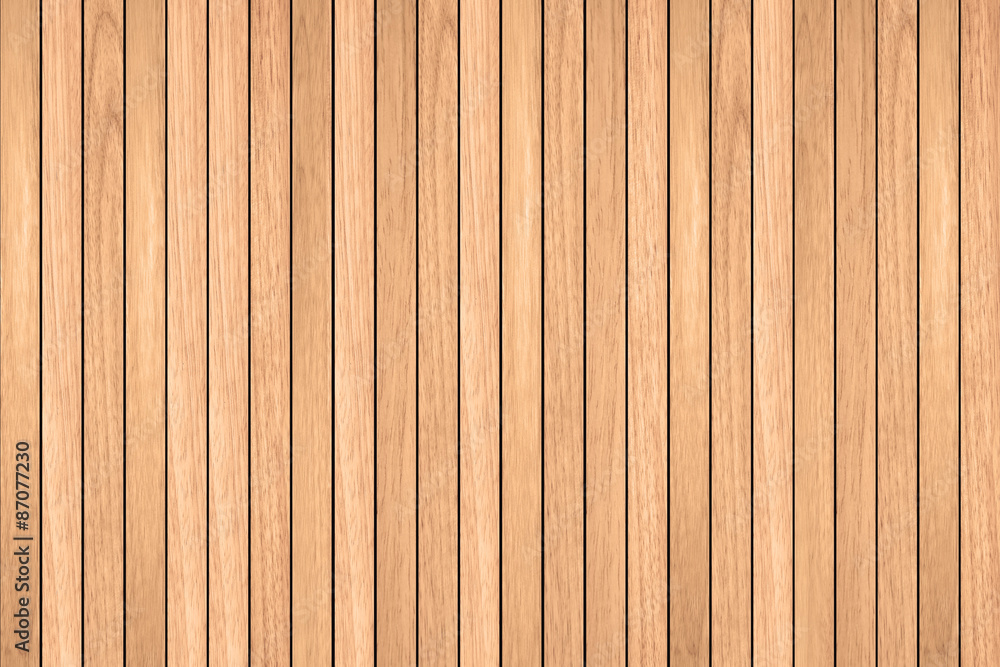
Garden room cladding comes in a variety of materials, each with its own set of pros and cons. Here’s a breakdown of the most popular cladding options:
1. Wood Cladding
- Popular Choices: Pine, larch, spruce
- Advantages: Wood provides a natural and rustic look, blending seamlessly with outdoor environments.
- Challenges: Regular maintenance like sanding and treating is necessary to keep it weather-resistant and prevent rot.
2. Cedar Wood Cladding
- Popular choices: Western Red Cedar, Siberian Larch
- Advantages: Cedar has natural oils that make it highly resistant to weather and rot. It also has a beautiful grain and colour that requires no staining or painting.
- Challenges: Can be expensive compared to other wood options.
3. Composite Wood Cladding
- Popular choices: Fibre cement cladding, PVC coated composites
- Advantages: Resistant to rot, insect damage, and warping. Low maintenance and can mimic the look of real wood or stone. Composite wood cladding is blend of wood fibres and plastic, composite cladding combines the aesthetics of wood with the durability and low maintenance of vinyl.
- Challenges: Composite wood cladding Can be more expensive than traditional wood materials.
4. Vinyl Wall Cladding
- Popular Choices: PVC, UPVC
- Advantages: Vinyl Cladding is more cost effective, Resistant to rot and insect damage. Easy to clean and maintain. Comes in a variety of colors and styles.
- Challenges: Can be less visually appealing compared to other cladding options.
5. Metal Garden Room Cladding
- Popular Choices: Aluminium, steel
- Advantages: Highly durable, modern, and weather-resistant. Metal cladding is ideal for industrial aesthetics.
- Challenges: Could be prone to dents and scratches.
6.Timber Cladding
- Popular choices: European Oak, Siberian Larch
- Advantages: Timber cladding is a sustainable option and offers a natural warmth to any outdoor space.
- Challenges: Regular maintenance is required to prevent rot and maintain appearance.
7. Stone Cladding
- Popular choices: Slate, granite, limestone
- Advantages: Stone cladding adds an elegant and timeless element to any garden room. It’s highly durable and low maintenance.
- Challenges: Can be more expensive than other options and requires specialized installation techniques.
8.Fibre Cement Cladding
- Popular Choices: HardiePlank, Cembrit Plank
- Advantages: Fibre cement boards are resistant to fire, rot, and insect damage. It’s also low maintenance and comes in a variety of colours and finishes.
- Challenges: Cement Fibre boards may be more expensive than other options.
Factors to Consider When Choosing Exterior Cladding
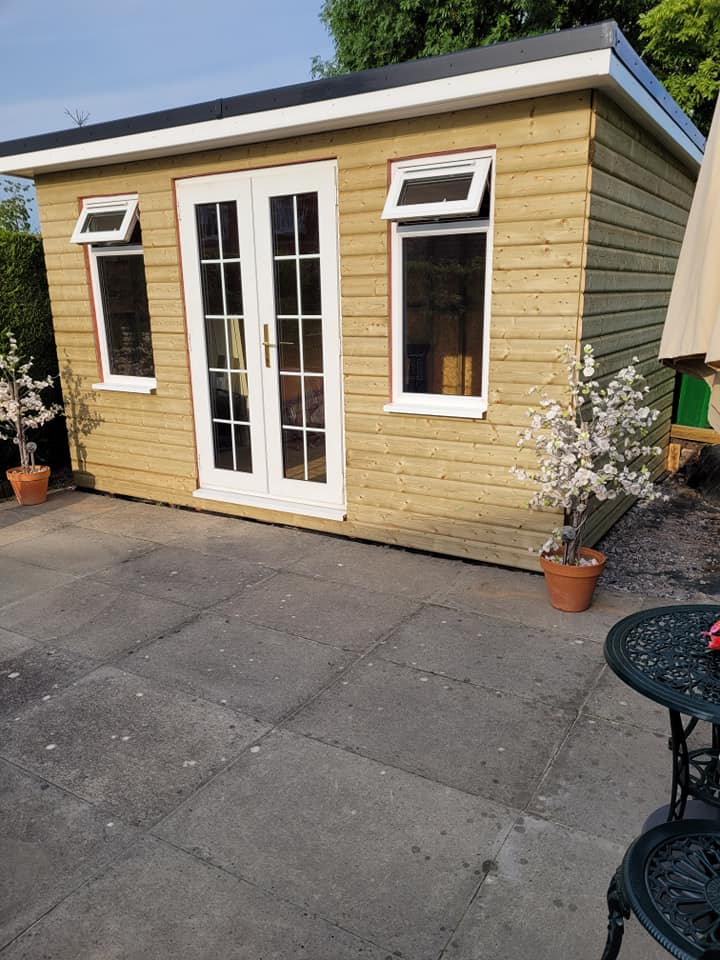
Selecting the perfect exterior cladding for your garden room involves considering a few key factors.
- Durability: Can the material withstand your climate’s specific weather conditions? Look for materials that are resistant to rain, UV rays, and occasional knocks.
- Weather Resistance: Opt for moisture-resistant materials (like cedar or composite cladding) if you live in a rainy or humid climate.
- Maintenance: Consider how much upkeep you’re willing to commit to. Timber cladding may require ongoing treatments, while vinyl and composite cladding are relatively hands-off.
- Aesthetic Appeal: Choose an exterior cladding material that complements your garden room design and outdoor space.
- Budget: Factor in not only cost per square foot but also long-term maintenance costs.
- Insulation: For all-year-round use of your garden room, pick a cladding material with good insulation properties to regulate internal temperature.
- Doors and Window Frames: Consider how the cladding will integrate with doors and window frames, ensuring a cohesive and visually appealing look.
Step-by-Step Guide to Cladding a Garden Room
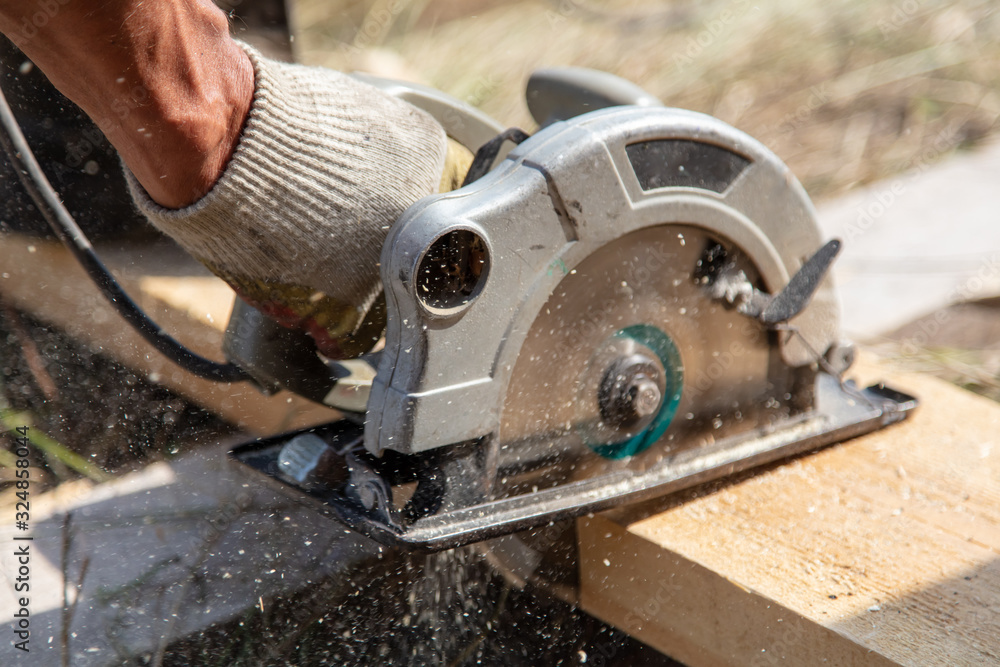
If you’re ready to roll up your sleeves, here’s how to get started with cladding the exterior walls on your garden room project.
Step 1. Preparation
- Remove any old or damaged exterior cladding if applicable.
- Ensure the garden room’s frame is sturdy and in good condition.
- Measure the garden building walls carefully and ensure the surface is clean and level.
Step 2. Gathering Tools and Materials
You’ll need the following items:
- Cladding boards of your chosen material
- Screws, nails, or adhesive (depending on the material)
- Saw for cutting boards
- Spirit level or laser level
- Protective gloves and safety goggles
Step 3. Install Battens (if Necessary)
For some cladding types, battens are used to create a framework onto which the cladding is fixed.
- Install treated timber battens vertically or horizontally.
- Space them evenly, typically 400mm apart.
Step 4. Cutting and Fitting the Exterior Cladding
- Cut the cladding to your necessary lengths using a saw.
- Begin fixing the boards at the base, working your way upwards.
- Use a spirit level to ensure perfectly straight placement.
Step 5. Fixing the Cladding to the Garden Room
- Attach the cladding boards securely to the framework using screws, nails, or adhesive based on the material specifications.
- Overlap boards where necessary to prevent water ingress.
Step 6. Finishing Touches
- Sand and treat wood/timber cladding as needed.
- Paint or stain for added protection and aesthetics.
- Composite cladding can be cleaned and maintained with a mild detergent and water.
Maintenance Tips for Garden Room Cladding

Different exterior cladding materials require different levels of maintenance. Keep your garden room cladding looking impeccable with these tips.
- Wood and Timber Cladding: Regularly sand and apply weatherproof sealant or stain. Inspect for any signs of rot or warping.
- Cedar Cladding: Treat cedar cladding annually with oil to retain its rich colour. Left untreated, cedar will naturally weather to a silvery-grey finish.
- Vinyl Cladding: Wash gently with soapy water to remove dirt and grime.
- Metal Cladding: Inspect for dents or scratches and repair as needed to avoid rust. Use a protective coating if not pre-applied.
- Composite Cladding: Clean composite cladding occasionally with water to remove dust and maintain its appearance.
- Fibre Cement Cladding: Low maintenance, wipe down occasionally to remove dirt.
Real-Life Examples of Garden Room Cladding
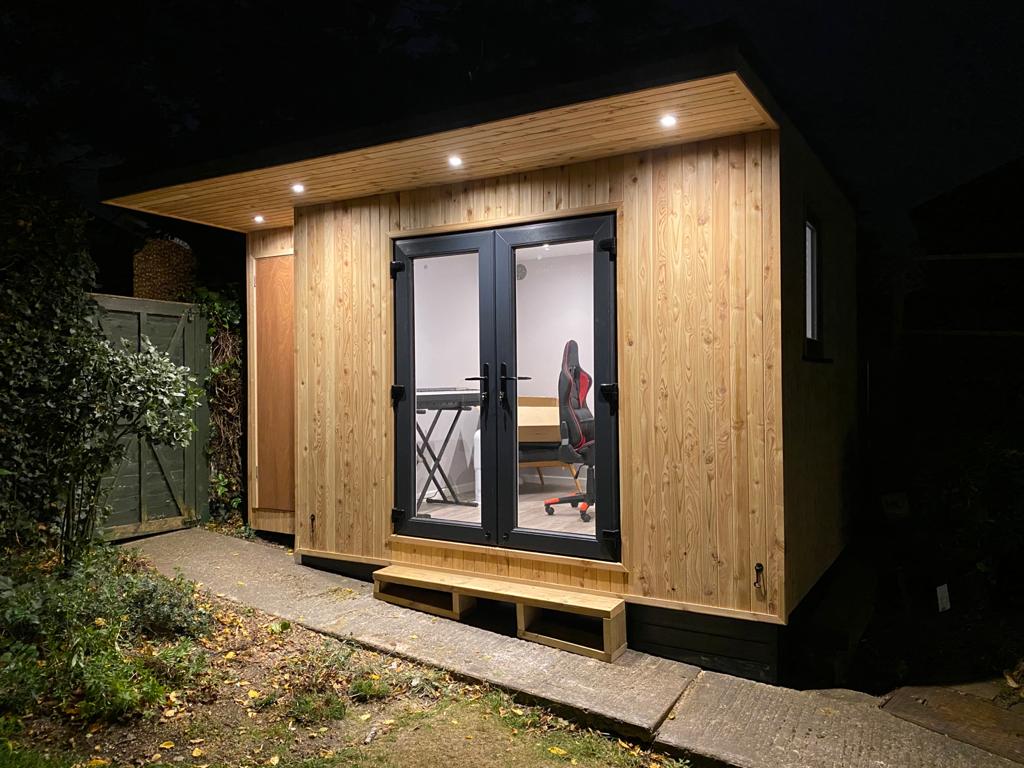
Before and After Example 1
- Before: A plain, undecorated garden room with a basic plywood exterior.
- After (Cedar Cladding): A high-end, spa-like garden retreat with warm tones and a modern edge.
Before and After Example 2
- Before: A small garden office with white vinyl siding and no character.
- After (Composite Cladding): A stylish, weatherproof garden office resistant to wear-and-tear from kids playing in the yard.
The Benefits of Exterior Cladding For Your Garden Room
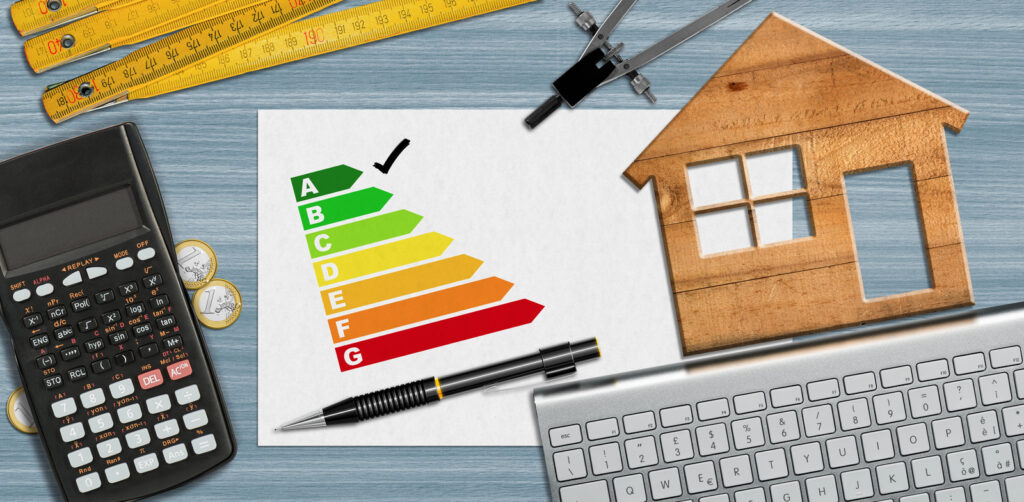
Why should you invest your time, money, and effort into cladding a garden room? Here are the key takeaways.
Functional Benefits
- Weather Protection: Keeps the garden room structure safe from rain, UV rays, and extreme temperatures.
- Durability: High-quality cladding can extend the life of your garden room.
Aesthetic Benefits
- Visual Appeal: Enhances the look of your garden room design, outdoor space and adds to the overall landscape design.
- Customization: Choose from a variety of styles and colours to suit your personal taste perfectly.
Financial Benefits
- Boosts Property Value: A well-clad garden room can increase the appeal and value of your home.
Bring Your Garden Room Cladding Vision to Life
Cladding offers countless ways to elevate your garden room, making it not just functional but also an essential part of your outdoor haven.
With so many exterior wall cladding options from the rustic warmth of cedar or the sleek durability of composite, take the time to find what’s right for you. Your garden room is an investment in your personal space that can be enjoyed for many years to come.

